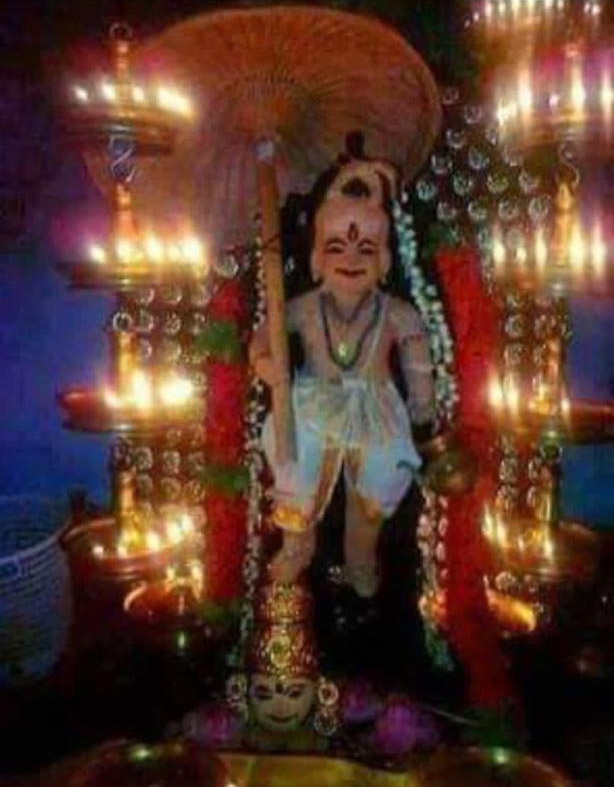
Rakshabandhana is celebrated on the full moon(Purnima) of Shravana month of the Hindu calendar. When the full moon is in the lunar mansion of Shravana Nakshatra (alpha and beta aquilae in the constellation of Capricorn) the Vedic lunar month of Shravana ends. The usual time is in the afternoon when the moon is actually a full moon, not preceding or transiting into the next phase.

Raksha bandhan is characterized by tying of the protective amulet, usually by a sister around the wrist of her brother. In the ancient age, priests used to tie it around the wrist of the king or their Yajamana. The festival is described in this form by Hemadri in his famous work ‘Chaturvarga Chintamani’ while dealing with Vratas (fasting and festivals) in the early 13th century. He has relied on the tradition as mentioned in the Bhavishyottara Purana where in the tying of the amulet by Indrani to protect her husband Indra has been mentioned.
The mantra which the priest utters while tying the protective amulet is
येन बद्धो बली राजा दानवेंद्रो महाबली।
तेन त्वाम् अभिबध्नामि रक्षे मा चल मा चल।।
The English translation of this mantra, called Raksha Mantra, is-
“ I am tying a Raksha to you, similar to the one tied to Bali, the powerful king of demons. O Raksha, be firm; do not waver.”
(Picture-A close up of the रक्षा मंत्र in Bhavishya Puranam Uttara Khanda chapter 137 verse no 20 is given here:…….)
The above Raksha mantra is popularly spoken when a Raksha in the form of a red-yellow thread (also called a mauli or kalawa) is tied by the priest during the various rituals, usually at the time of Sankalpa (vow) or Phalashruti (result declaration) as the final step.
The tradition of protection wish from a wife-husband or priest-patron pair gradually evolved into a sister-brother festival wherein now the sisters tie rakhi ( also derived from Raksha) around the wrist of their brothers, wishing their well-being and protection from the worldly evils. The brothers offer return gifts to them. Temple and family priests on this day tie Mauli (protective thread) around the wrists of their Yajamanas and are paid dakshina ( donation). It is important to observe that the role of brothers was always crucial in the Hindu community in which sanguineous marriages are not permitted and who hold their priestly class in a high esteem. In the medieval times, the brothers were expected to be ever ready for engaging the Moslem assailant with the possible motive of abduction and exploitation of their sisters. Today this sort of a threat does not exist any more but the sentiments of a loving sister- brother relationship does exist as a perpetual tradition of Rakshabandhana.

The ever evolving Hindu religion has extended the Raksha sentiment to contemporary settings. People tie Rakhi to soldiers who guard the borders of our country. People tie Rakhi around trees with a vow to protect the environment.
A famous legend goes on to say that on this day King Bali, who was conquered by Lord Vishnu in his Vamana incarnation, goes back to his kingdom in the netherlands (Paatala) after a ten day sojourn of the Earth, which was his erstwhile kingdom. The period of 10 days is considered very sacred in South especially in Kerala, where ‘Onam’ festival is celebrated at the culmination. It coincides with the rise of the Shravana Nakshatra which they call ‘thiru onam’ while the Sun traverses Chingam zodiac (Leo constellation).The Vedic Name of Shravana Nakshatra was ‘Shrona’ (श्रोणम्) and Leo is called Simham- it bears a close Malayali connect! The seas are turbulent in the South since June and the end of Shravana month announced weakening in the intensity of monsoon. Hence, coconut and other offerings are made to the seas and farming and fishing community pray for the safety of their boats and harvest.

In Odisha, in the East, Gamha Purnima is celebrated on the full moon day (Poornima) in Shravan month. It is observed as the birthday of Balabhadra (Baladeva), the eldest brother of Bhagavan Sri Krishna and the two brothers along with their sister Subhadra are tutelary deities of Sri Jagannath Puri. Hence people also celebrate Gamha Purnima as Raksha Bandhan imitating the Rakhi festival between brothers and sisters. Krishna, being the protector of cows, in some regions of Odisha, cows and bullocks are also worshipped on Gamha Purnima.
The tradition of Raksha existed in the Vedic period. The Grihya Sutras prescribed special rituals on this day which were called Shravani or Shravana karma (श्रावणी/ श्रवण कर्म). There used to be a special ritual of snake worship, in which roasted barley and special ghee-soaked tortilla ( ghrit-sthalipaka) was offered in the sacrificial fire (yajnya) and a portion of the offering was kept for serpents.The ritual of protection against the danger of snake bite, which is maximum during the rainy season as burrows are water-logged, is alive in our culture. Even today, the festival of Nagpanachami is celebrated in the month of Shravana, ten days before Rakshabandhana.
Rainy season was a period of learning and practising austerity in ancient India, both in the Vedic religion and its offshoots, Buddhism and Jainism. The ritual of initiating the study of Vedas usually commenced on this day and it was called Shravana -Veda- upakarma when the Acharya tied Mekhala and yajnyopavita ( sacred thread) on his young disciple. This practice continued in the Purana period as mentioned in the Chapter 124 of Naradiya Purana-


At Lord Krishna’s Guruvayoor temple, in Kerala, on the day of Thiru Onam, Diety adorns the ‘Vamana Alankara’- the costume of Vamana, one among Lord Vishnu’s ten incarnations (Dasavatara). The Mythology says that Raja Maha Bali was banished from his kingdom on the Earth Planet to PatalaLok by Lord Vishnu donning Vamana Alankara.This Vamana Alankara at Guruvayoor is shown only on one day in a year, that is during Keralaites Onam festival time and the Rakshabandhana in the North.

